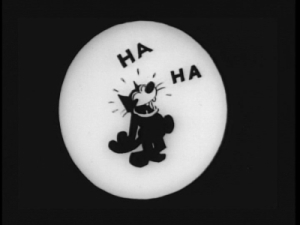At the recent Licensing Expo, DreamWorks Animation announced that it had purchased the rights to Felix the Cat, a cartoon icon dating from animation’s silent period. In acquiring this “true icon,” CEO Jeffery Katzenburg said, DreamWorks will attempt to turn the nonagenarian cat into “one of the most desired fashion brands in the world.”
This isn’t the first time an animation company has taken an interest in characters from the silent period. Disney, most notably, recently bought the rights to Oswald the Lucky Rabbit — Walt’s pre-Mickey star who was taken from the Disney studio in 1928. At Disney, Oswald has become a video game character, appears on merchandise and in the parks alongside other characters, and there are even “Oswald Ears” to rival the well-known Mickey Ears. In purchasing Felix the Cat, it would seem that DreamWorks is going to attempt a similar transformation. In my (completely unsolicited) opinion, this is a mistake for DreamWorks as they attempt to create a coherent image for the studio.
As early animated icons go, its clear why Felix would seem to be a desirable figure, and one capable of competing with the Disney brand. Following Windsor McCay’s Gertie the Dinosaur, a whole new generation of animators became enthralled with the possibility of animation as a career and an impressive number of tiny cartooning companies were founded, though many quickly dissolved after failing to find distributors.[1] At this time, three production groups managed to prosper in the cartoon industry. Max Fleischer and his brother Dave developed their first series, “Out of the Inkwell,” and Paul Terry created a successful series of animated stories based loosely on Aesop’s Fables. But the most popular, most skillfully animated, and most economically successful cartoon character in this period was Pat Sullivan’s Felix the Cat.
At the height of his fame, nearly three-quarters of the world could recognize the frisky feline, whose unique sight gags inspired many early animators, including those at the Disney Brothers studio.[2] Felix established the possibility of a cartoon star, capable of attracting audiences on his own terms. This star power would later by used most effectively by Mickey Mouse, who shot to stardom through his role in one of the most influential moments in cartoon history: the debut of Steamboat Willie and the supremacy of the sound cartoon.
Contrary to popular opinion, Steamboat Willie was not the first sound cartoon. In fact, Sullivan had previously released several Felix the Cat cartoons that combined music and graphics. The triumph of Steamboat Willie was not that it managed to include sound, but rather that the sound was used to drive and enhance the gags that had made the cartoon funny in the first place. With the use of sound as pioneered by Disney, sound was used to support the animation, rather than replace it. Sound gave the flat animation of cartoons a gravity and volume that allowed for more audience enjoyment of the events on screen.[4] Mickey Mouse, with his high squeaky voice, quickly became an international success; Felix, in spite of a few attempts at revival, was largely forgotten.
With Felix, it seems that DreamWorks made an appropriate choice, if the intention is to rival Disney’s restored historical characters. However appropriate the rivalry, I cannot help but think that this feels like a huge mistake for a company that has made such strides in establishing their own studio’s distinct approach to animated features.
There are two major differences between Disney’s purchase of Oswald and DreamWork’s purchase of Felix. First there is the fact that, at one point, Oswald was Disney’s, so inducting the character into their roster seems less artificial. DreamWork’s Felix, on the other hand, feels suspiciously like someone buying family photos at an antique store – nice to look at but missing some of the historical ties that give so much value.
Moreover, Disney has always been historically-minded. Between the studio’s loss of Oswald in the 20’s (which led to the studio’s fastidious protection of its intellectual property to this day) and Walt’s own love of nostalgia (as seen in the creation of the 1890s themed Main Street at the parks), Disney has worked to create an image of the studio as historically rooted and unabashedly sentimental. Their films, shorts, merchandise, parks, and even personnel reflect and support this image of the studio, and this is part of what makes the Disney brand so persuasive.
At its best, DreamWorks Animation offers us an alternative to the Disney brand, and their best films reflect this. Shrek gives us a good look at the ways DreamWorks steps out of the Disney-brand shadow: relentlessly funny, not afraid to be risky (or even slightly risqué) with the plot or punchlines, and heavily based in current popular culture (as opposed to Disney’s “timelessness”). Their films from the past few years (Kung Fu Panda, Monsters vs. Aliens, The Croods) have all helped to reinforce this image. Acquiring Felix feels like a step backwards, as if being Disney-Lite is really preferable to distancing themselves.
Of course, I may be proven wrong in time. After all, I did enjoy their re-imagining of Mr Peabody and Sherman, in spite of critics’ (and the box office’s) tepid response. Moreover, I have no doubt that DreamWorks will be successful in marketing Felix, as there will surely be people who find the character’s history and revival appealing. Whatever happens, it would be nice to see Felix finally get a little of the respect he deserves — he is, after all, quite an old cat.
[1] Bendazzi, Cartoons, 53-54. [2] Solomon, Enchanted Drawings, 17. [3] Gregory A. Waller, “Mickey, Walt, and Film Criticism from Steamboat Willie to Bambi,” ed. Danny and Gerald Peary (New York: Dutton, 1980), 51-52. [4] Norman M. Klein, Seven Minutes: The Life and Death of the American Animated Cartoon (London; New York: Verso, 1993), 9.

Pingback: Winter/Spring Animated Film Preview 2015 | 540 Feet